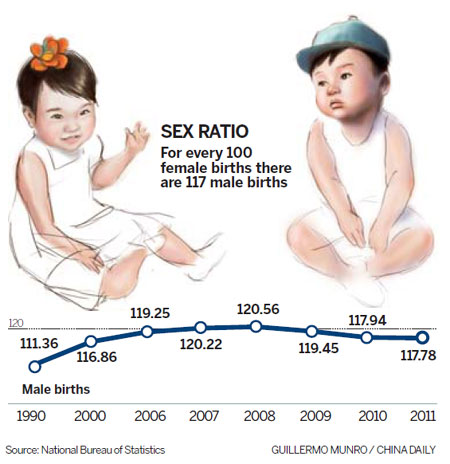Gender imbalance set to ease
 0 Comment(s)
0 Comment(s) Print
Print E-mail China Daily, March 30, 2012
E-mail China Daily, March 30, 2012
The skewed birth sex ratio, with more than 117 males for every 100 females, is targeted to drop to below 115 by 2015, a senior population official said.
 The ratio stands at exactly 117.78 males born for every 100 females, official statistics showed. It peaked in 2008 at 120.56.
The ratio stands at exactly 117.78 males born for every 100 females, official statistics showed. It peaked in 2008 at 120.56.
"Despite a decline over the last three years, the situation, compared to the 'normal ratio' of 103 to 107, is still severe and government-led intervention is necessary," Zhang Jian, publicity chief of the National Population and Family Planning Commission, said.
"It will be a tough task to meet the 2015 goal and an intense effort is needed," he told China Daily on Thursday.
Last August, the commission and other government agencies, including the Ministry of Health and the Ministry of Public Security, launched a national campaign to curb non-medical sex determination and sex-selective abortions.
"We'll extend that campaign into this year," Zhang said.
Zhai Zhenwu, head of the social and population college at the Beijing-based Renmin University, said there was a deeply rooted tradition of preferring male births.
As fertility rates declined due to the family planning policy, the figure for male births surged ahead, he said.
The increasing availability of ultrasound technology, enabling fetus gender testing on the mainland in the 1980s, made sex selection easier and led directly to an increasingly imbalanced gender ratio, he explained.
And "it's easy to access such tools, particularly at the grassroots," he added.
"Campaigns will help stop sex-selective abortions and address the 'marriage squeeze,' which is expected," he said.






Go to Forum >>0 Comment(s)